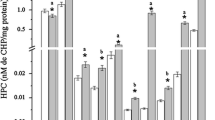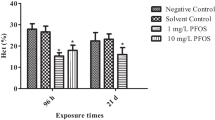Abstract
The effect of DNB (Dinitrobenzene) wastewater on Cyprinus Carpio was studied. The effluent was found to be very toxic even at low concentration with 0.052% (V/V) at 96 hr LC50. Various biochemical responses of Carp such as O2 consumption, NH3 excretion, protein, glycogen and lipid contents were measured and statistically evaluated. The effect of this effluent on Carp reduces O2 consumption and NH3 excretion and also interferes with the metabolism of the fish. The high toxicity of the effluent is attributed to the combined effect of a mixture of nitroaromatics present in the effluent.
Similar content being viewed by others
References
APHA, AWWA, WPCF, Standard Methods for Examination of Water and Wastewater: 1975, 14th ed. APHA. Inc. New York.
Brock, W., Bronson, D. R., and Blau, G. E.: 1974, E.S.T. 8, 1113.
Cody, T. E., Witherup, S., and Hastings, L.: 1981, J. Toxicol. Environ. Hlth. 7, 829.
Finney, D. J.: 1971, Profit Analysis, Cambridge University Press, Cambridge 333 pp.
Hamblin, D. O.: 1963, Aromatic Nitro and Amino Compounds in Industrial Hygiene and Toxicology, Vol. 2, D. W. Fassett and D. D. Irish (ed.), Interscience Publishers, New York, pp. 2105–2169.
Hassid, W. Z. and Abraham, S.: 1957, Methods in Enzymology, Vol. 3 Colowick and Kaplan (ed.), Academic Press, New York.
INDO-US Project report: 1983, ‘Analysis, Assessment and Treatment of Toxic Discharges from Phosphatic Fertilizer and Basic Organic Chemical Industries’, NEERI, INDIA, Final report.
Jones, J. R. F.: 1964, Fish and River Pollution, Butteworths: London 204 pp.
Jrueger, H. M., Saddler, J. B., Chapman, G. A., Tinsley, I. J., and Lowry, R. R.: 1968, Amer. Zool. 8, 119.
Leo, A., Hansch, C., and Elkins, D.: 1971, Chem. Rev. 71, 525.
Lowry, O. M., Brough, N. J. R., Farr, A. L., and Randal, R. F.: 1951, J. Biol. Chem. 193, 265.
Spanggord, R. J., Mortelmans, K. E., Griffin, A. F., and Simmon, V. F.: 1982, Environ. Mutagen 4, 163.
US EPA: 1975, ‘Methods for Acute Toxicity Studies with Fish Macroinvertibrates and Amphibians’, USEPA Committee on the methods for Toxicity Studies with aquatic organisms, Oregon, 64 pp.
Author information
Authors and Affiliations
Additional information
Author for all correspondence
Rights and permissions
About this article
Cite this article
Kumar, N.J., Krishnamoorthi, K.P. & Rao, D.M.R. Toxicity and biochemical responses of carp to dinitrobenzene plant effluent. Water Air Soil Pollut 28, 117–126 (1986). https://doi.org/10.1007/BF00184074
Received:
Revised:
Issue Date:
DOI: https://doi.org/10.1007/BF00184074




